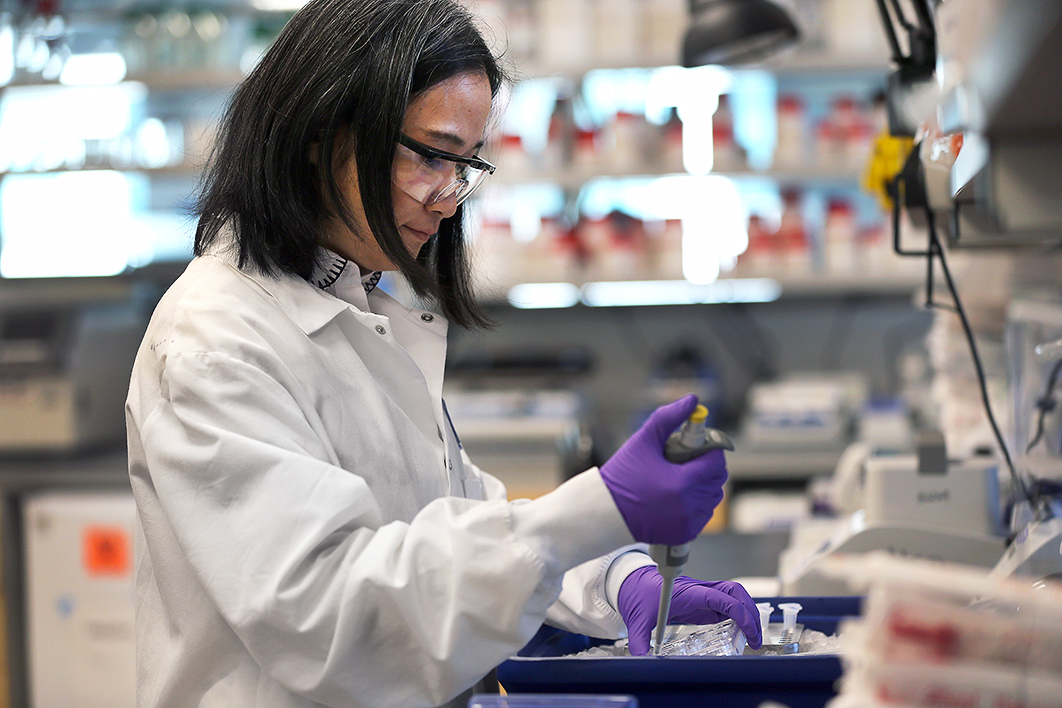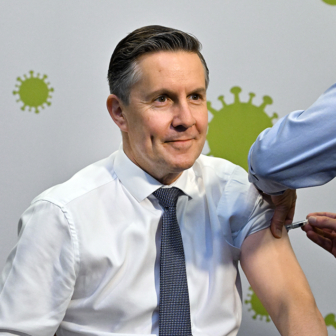At one of the early Australian conferences on AIDS back in the 1980s, I was talking with a gay GP during the tea break. We had just heard from one presenter that oral sex was unlikely to transmit HIV. “What a relief,” he said. “I had been thinking we were all going to die.” I wasn’t sure whether he meant that all gay men would already have been infected, or that giving up oral sex was a bridge too far. Perhaps it was a bit of both.
Even though an HIV test had become available by then, not many people had so far been tested. With no effective treatment available, the prevailing view in the gay community was that it was better just to assume everyone was infected. That had two effects: it meant the responsibility to practise safe sex was shared between everyone, putatively infected or not; and it built solidarity between those becoming sick and those who were still well. For the healthy, it was either just a matter of time until sickness came or “there but for the grace of God go I”; either way, there was no room for judging those with AIDS.
Pandemics seem to have a rhythm. At first, after the alarm is sounded, it all seems far away and implausible. Then comes a phase of downplaying the risk — it won’t come here, it’s not so bad anyway — followed by a polarised debate about whether the official responses are too timid or too extreme (inevitably with economics as much in evidence as health). Then comes a full-on response (and however much we rationalise away the thought “We’re all going to die,” it finds ways of sneaking back). Then there is adjustment, resignation and coping with the new reality. And finally come signs that the worst is over, rarely building to a crescendo but usually to a creeping sense of relief. Perhaps only in retrospect do you realise the burden has been lifted.
In recent days an apocryphal Lenin quote has been doing the rounds: “There are decades where nothing happens; and there are weeks where decades happen.” This has been just such a week, with evidence of the exponential growth in the number of Covid-19 cases in Europe, the Americas and Australia. The core public health goal has coalesced around flattening the curve of the epidemic before health services become overwhelmed.
The most critical piece of information was the public release on 16 March of the Imperial College Covid-19 response team’s modelling of the epidemic impact of Covid-19 in Britain and the United States. It mattered not only because this team is probably the world’s best epidemic modeller, but also because the paper was intelligible as much to policymakers as to epidemiologists (and of course to armchair versions of both).
The modelling suggested that given what was known about the spread of SARS-CoV-2 (the virus name — the disease it causes is Covid-19), letting the epidemic spread with no response would result in 81 per cent of the British and US populations becoming infected, with 510,000 and 2.2 million deaths respectively. Mitigating the epidemic through case isolation, quarantining of affected households, and social distancing of people over seventy would halve the deaths but still result in eight times the current critical care capacity of both countries’ health systems. The only strategy that could keep demand for intensive care beds within capacity would involve suppressing the epidemic through school and university closures, social distancing for the total population, case isolation and household quarantine.
The Imperial College team modelled this approach for a maximum plausible duration of five months, building in an assumption that not everyone would comply. Crucially, the model suggested that the epidemic would rebound after measures were relaxed, to a peak nearly as high as would have been reached without the measures. They concluded that a partial relaxation would need to be mixed with a reinstatement of controls in certain localities as numbers started to rebound. All this is to prevent health system meltdown and buy time until effective treatment or vaccination becomes available.
In Australia, the week saw the progressive alignment of government and public health advice with a suppression strategy. The first signal came from the Australian Health Protection Principal Committee — the federal and state chief medical advisers — whose 17 March statement included a graph showing the daily growth of the epidemic since the one-hundredth case was identified. It showed Australia on exactly the same path as Spain, France and Britain. Clearly, widespread community transmission was on the way, and a significant shutdown would be required.
The data on different national responses to Covid-19 is advancing in tandem with the pandemic. Adding to our sense of the success of the total shutdown in Wuhan and later Hubei Province in China is a growing recognition of the role hospital isolation may have played in curbing the epidemic there. Not only was movement curtailed, but those who tested positive to the disease were hospitalised in the temporary facilities thrown up in a matter of days. This type of isolation could obviously be more stringent than an instruction to isolate at home, and greatly restricted transmission from those with only mild disease.
China has already celebrated the descent from the peak of the epidemic, with zero new domestic infections recorded for the first time on 19 March. But the country is acutely aware of the possibility of epidemic rebound as new cases enter the country. It is too early to declare the complete success of an East Asian containment model, though. South Korea joined China in bending the curve of the epidemic, but has seen something of a resurgence in the past few days. Singapore kept numbers remarkably low but saw a worrying spike in infections on 17 March. Japan’s trajectory has been much flatter than others, but that may reflect low testing rates.
What has become much clearer in the past few weeks has been the extent of “covert” infections — the 60 per cent or so of infected people who have either no noticeable illness or hardly any, but who are likely responsible for the majority of onward transmission. For some, the answer is to test everyone, and the proof is the natural experiment of the town of Vò, where Italy’s first Covid-19 fatality led to the whole population of around 3000 people being tested. All ninety-five cases found and isolated in two rounds of testing recovered fully and new transmission was eliminated within a fortnight. Much as this account is cheering, it will be hard to replicate when it comes to larger and more diffuse population centres. And for the moment, the limiting condition is the availability of tests, with a worldwide shortage of reagents already affecting Australia’s capacity.
The most recent tranche of research funding from the Australian government has been directed at filling some of these gaps. The Peter Doherty Institute at the University of Melbourne is rushing to develop novel testing strategies that promise to greatly reduce the consumables needed. Meanwhile, tests for the antibodies produced by the immune response to exposure to SARS-CoV-2 have also been developed in the past month, and offer two advantages: rapid throughput and their capacity to detect people who have been infected but have recovered and cleared the virus, leaving only the antibodies as evidence of their infection. The latter is especially useful for epidemiologists attempting to gauge the full extent of the epidemic. Sydney company Atomo Diagnostics is hoping to adapt its current HIV self-test machine for Covid-19 antibody testing, a potential development that may have a significant bearing (as its prospectus carefully explains) on its current initial public offering of shares.
The trajectory of HIV testing is instructive. Initially, it was surrounded with caveats and admonitions: pre- and post-test counselling, rights protections, expert administration of the test by doctors and then by nurses. Today, counselling has been dispensed with (there was no evidence it made a difference — all people wanted to know was their test result), rapid HIV antibody tests are cheap (less than 50 cents) and can be administered with a minimum of training, and self-testing with on-the-spot results has proven to be feasible and free of negative consequences. You can order Atomo’s self-test kit online in Australia for $25 (and, in partnership with generics manufacturer Mylan, it is available for a lot less in developing countries).
The twenty-five years it took HIV testing to evolve to this point may be replicated in twenty-five days for SARS-CoV-2. Already, American companies are using ambiguous regulatory flexibility from the Food and Drug Administration to offer a mail-order testing service. Receive the test, mail back the self-administered swab samples, and they’ll text your results within forty-eight hours. Demand seems strong, with one company that offers the test for US$181 advising on its website when daily capacity has been reached.
Testing is at the pointy end of public disquiet concerning equitable responses to the pandemic. The steady drip of announcements of celebrities and politicians testing positive for Covid-19 seems to show that the well connected have no problems getting tested, while most Australians, unless they fit narrow criteria of probable exposure and illness, find themselves turned away. This will likely change, but if we are headed for infection rates of 30 per cent or more of the total population then the queue for testing will stretch out for a long time.
This pandemic strikes at a time when trust in government, social institutions and the media is low. Against this background, public health communication has a herculean task. Unfortunately, the core communication challenges for public health authorities — inconsistency and uncertainty — pull in opposite directions.
The Victorian government did not cover itself in glory when it exempted Crown Casinos from social distancing rules — only revoking this exemption this weekend — or when it failed to call off the Melbourne Grand Prix until the morning the gates opened. All it achieved was a cynical resignation to the notion that money trumps public health. Similarly, schoolteachers are justifiably indignant when social distancing regulations of four square metres for any gathering are manifestly not feasible in classrooms, yet schools are not closed.
Of course, all these decisions are trade-offs between calculations of epidemic spread, economic damage and social psychology. But if health authorities frankly admitted making these trade-offs on an uncertain information base, they would be excoriated for sowing doubt. Australia’s current solution seems to be to seek the maximum possible consistency from the chief medical officer flanked by politicians, and rely on the ABC’s Norman Swan to inject scepticism, confidence intervals and doubt as required.
There’s certainly plenty of uncertainty to go around. Why is the fatality rate in Italy so much higher than in Germany (or China)? Are younger people at significant risk of death, or aren’t they? Do ACE inhibitors for hypertension increase Covid-19 risks or not, and if they do, will the damage caused by people getting off these medications outweigh the potential reduction in Covid-19 risk?
The information is uncertain and the studies are under way, but in the meantime, as technology writer Venkatesh Rao points out, when the narratives desert us, we do the math: “That’s how you know everybody has lost the plot: everybody is tracking the rawest information they have access to, rather than the narrative that most efficiently sustains their reality.”
There can be pleasure in radical uncertainty, of course. It creates a “time out of time,” the numinous experience devoid of everyday calculation, familiar in studies of ecstasy whether religious or secular, sexual or transcendental. But when it is experienced on a mass scale, we fear that anarchy will break out.
The evidence from disaster studies is that chaos may be less likely than we assume. In 2008 the doyen of disaster sociology, Enrico Quarantelli, reviewed half a century of research into responses to catastrophe and disaster to lay bare six myths: that people try to flee in panic, that looting results, that those affected are dazed and passive, that necessary personnel abandon their posts to look after their families, that disasters have severe mental health consequences and that firm top-down control is needed.
Quarantelli found that the evidence, drawn from extensive accounts of a range of catastrophes and disasters, showed the contrary: panic was rare; in the few instances where looting occurred it was not indiscriminate but rather a response to specific pre-existing injustices; immediate and active responses emerged as soon as communities were affected; emergency personnel overwhelmingly played their role even if the needs of their families caused them stress and concern; mental health effects were mild and short-lived (and disasters can even have positive impacts on mental health); and central authorities were the source of most problems in disaster response.
While the media accounts of the aftermath of Hurricane Katrina suggested an outbreak of lawless despair, Quarantelli’s evidence paints a different picture:
What emerged on a massive scale were smaller informal entities and network linkages sometimes but not always anchored in pre-impact known groups. Their pro-social and very functional behaviour dwarfed on a very large scale the antisocial behaviour that also emerged. Improvisation and innovation took place because the everyday traditional routines could not be used or were ineffective in dealing with the problems that had to be addressed.
Crucially, though, disaster studies show these pro-social improvisations emerge when the disruption is perceived as a common threat, not as a conflict. Blame is not just an unproductive pandemic response, it is positively counterproductive. This is why president Emmanuel Macron solemnly declares, “We are at war with an invisible enemy.” Donald Trump has attempted the same pivot, last week characterising himself as a wartime president, but he and his administration seem unable to resist the temptation to blame the “Chinese virus” just like those who persisted in referring to AIDS as “the gay disease” while maintaining they were just “stating the facts.”
So there are choices to be made, and some of them may be good ones. Following the adage of never letting a crisis go to waste, the radical destabilisation in the wake of the onset of the Covid-19 pandemic suggests some solutions to hitherto intractable social problems. The US government found it could create an entitlement to sick leave, the British government has guaranteed lost incomes, and the Australian government boosted assistance to the unemployed (albeit as a one-off rather than an ongoing commitment). In the face of massive shutdown job losses, campaigners for a universal basic income are suddenly finding policy audiences much more receptive.
The extent to which the current crisis results in increased social solidarity and greater equality remains to be seen. The sight of empty supermarket shelves suggests pernicious and competitive individualism has more than a few adherents. But I prefer to have faith in the empirical evidence that ground-up solidarity building will be the predominant response.
The hardest thing to do in a crisis is to maintain a sense of perspective. It is one of the reasons pre-planning happens, which means that Australia’s current template draws on the plans developed to respond to potential pandemic influenza. Last week, as a member of my local hospital board, I participated in a committee meeting by phone in which the senior staff went through the organisation’s contingency plans. It was strangely comforting to hear about the planned responses at different degrees of epidemic escalation and know that for whatever scenario, a scaled response would be put in place. While triage seems an affront in any immediate personal health situation — I must have maximum care right now — it is a daily reality for health services even in the best of times.
The first peak of Covid-19 illness will pass. Rebounds will come. Meanwhile, extraordinary improvisation is happening for the good. The Victorian Infectious Diseases Reference Laboratory has achieved an unprecedented decentralisation of testing facilities down to local level, coming on stream this week. In the world’s densest precinct of biotech innovation, right next to MIT, Moderna’s vaccine candidate based on messenger RNA went into phase 1 human trials on 16 March — an astonishingly fast process using a new, highly designed and yet-to-be-proven way of conceptualising vaccine development. Since February, the Coalition for Epidemic Preparedness Innovations has pumped funding into seven candidate vaccine projects, including one at the University of Queensland. And last Friday the World Health Organization launched SOLIDARITY, a coordinated multi-country trial of four of the most promising treatments for Covid-19.
I don’t know of a similar catalogue of social innovations in response to Covid-19, but it would be good to have one: block by block, city by city they are undoubtedly emerging. I hold out no hope for a deus ex machina. But I do for the cumulative accretion of steps of solidarity, innovation and adaptation. That seems enough to go on with.
Meanwhile, in the service of amassing raw data, what am I reading?
• The World Health Organization’s updates
• Case report updates from Johns Hopkins University and the nifty graphs you can build yourself of selected country trajectories
• The Lancet’s Covid-19 resource centre
• Nature’s coverage
• The International Health Policies Network weekly update
• Somatosphere’s series, Dispatches from the Pandemic
• STAT’s coverage
• The Australian health department website and particularly the Australian Health Protection Principal Committee’s statements. •




